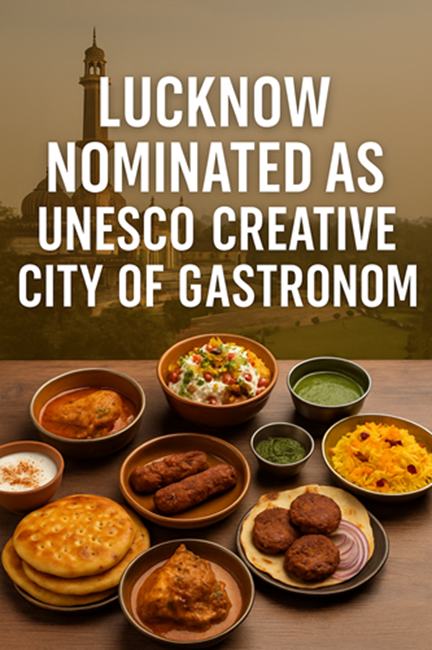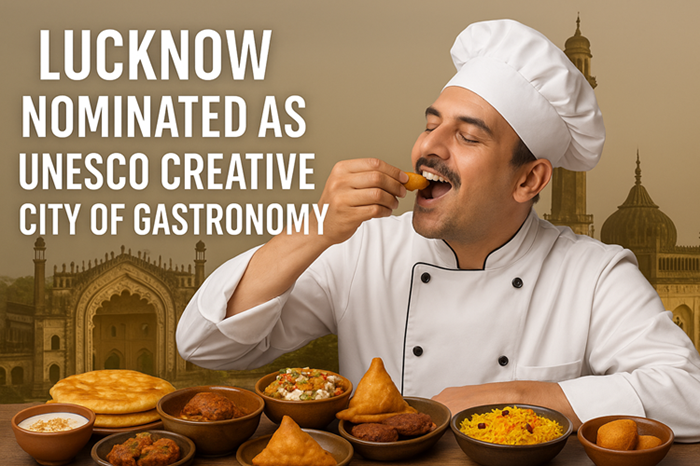“In Lucknow, food isn’t just cooked — it’s composed like poetry, where each spice pens its own verse in a slow, soulful symphony.”
Introduction: A Nomination That Reflects a Culinary Legacy
The historic city of Lucknow, long celebrated for its Nawabi culture and royal cuisine, has been nominated for inclusion in the UNESCO Creative Cities Network under the Gastronomy category.
This prestigious nomination isn’t just a nod to Lucknow’s globally loved biryani and kebabs — it is an acknowledgment of a rich culinary tradition that spans more than 200 years, fusing history, culture, artistry, and flavors into a single, unforgettable gastronomic experience.
As someone who has walked the food trails of Lucknow, tasted spices that feel centuries old, and seen recipes guarded like family heirlooms, I can say: this nomination is long overdue.

Why UNESCO Is Considering Lucknow for Gastronomy Recognition
UNESCO’s Creative Cities Network identifies cities that place creativity at the heart of their development strategy — and when it comes to gastronomy, it’s about preserving culinary traditions, fostering sustainable food culture, and engaging communities through food.
So, why Lucknow?
- Awadhi cuisine with a global fanbase.
- Centuries-old cooking techniques like dum pukht and baghar.
- A unique blend of Persian, Mughal, and local influences.
- Strong community involvement in food storytelling and festivals.
- A diverse balance of vegetarian and non-vegetarian dishes that define its inclusive culture.
Beyond Biryani & Kebabs: Lucknow’s True Culinary Spectrum
Yes, Lucknow’s biryani is famous.
Yes, the kebabs are legendary.
But this nomination is about so much more.
In Lucknow, food isn’t simply cooked — it’s composed. It’s slow, thoughtful, elegant, and deeply emotional.
Iconic Non-Vegetarian Dishes of Lucknow
- Galouti Kebab – Soft, spiced, and rich with legend.
- Kakori Kebab – Silkier, juicier; once served to royalty.
- Awadhi Mutton Biryani – Subtle flavors, saffron, and slow-cooked love.
- Tunday Kababi’s Kebab – Over 100 spices and 100 years of history.
- Nihari with Kulcha – A breakfast legacy made from slow-simmered mutton stew.
- Shami Kebabs – Spiced lentil and meat cutlets, melt-in-mouth.
- Pasanda – Flattened lamb marinated and cooked in creamy nut-based gravy.
- Murgh Musallam – Whole chicken with eggs inside, fit for Nawabs.
- Keema Kaleji – A flavorful treat often reserved for festivals.
- Sheermal & Rogan Josh Combo – The ultimate comfort food duo.
Vegetarian Treasures of Lucknow’s Cuisine
While non-veg steals the headlines, Lucknow’s vegetarian heritage is equally rich.
- Tokri Chaat (Basket Chaat) – A crispy potato basket overflowing with flavor.
- Khasta Aloo – Crisp puris with tangy aloo curry, a breakfast staple.
- Mewa Pulao – Saffron-scented rice rich with dry fruits and royal notes.
- Dal Sultani – A Nawabi lentil dish with ghee, garlic, and charcoal smoke.
- Navratan Korma – A creamy mix of nine vegetables and dry fruits.
- Paneer Shammi Kebab – A vegetarian twist on the classic Shami.
- Baingan ka Bharta Awadhi-style – Smoky brinjal mashed with unique spices.
- Zarda Pulao – A sweet rice preparation with rose water and cardamom.
- Kachori-Sabzi – Crisp on the outside, soul-soothing on the inside.
- Sheermal with Veg Nihari – A surprisingly satisfying royal veg meal.
Sweet Notes: Lucknow’s Royal Desserts
- Makhan Malai – Winter’s most delicate treat, light as air.
- Malai Gilori – A creamy, soft paan-shaped dessert made from milk skin.
- Sheer Khurma – A rich festive delight with vermicelli and dates.
- Imarti & Rabri – A divine end to a Nawabi meal.
- Rewri-Gajak – Crunchy winter specials.
200 Years of Culinary Poetry
Lucknow’s culinary culture didn’t come from trends — it came from traditions.
During the 18th and 19th centuries, Awadhi cuisine was born in royal kitchens where chefs (or rakabdars) created food that was as artistic as it was flavorful. Dishes were slow-cooked, recipes handwritten, and ingredients often included rose petals, kewra, saffron, vetiver, and ittar (perfume).
The dum pukht style — slow cooking in sealed pots — became a defining feature of Lucknowi food.
Even today, many of these traditions are preserved not in restaurants, but in homes, passed down from generation to generation.
Where to Taste Authentic Lucknowi Food
| Dish | Best Place to Try |
|---|---|
| Galouti Kebab | Tunday Kababi, Chowk |
| Basket Chaat | Royal Café, Hazratganj |
| Mutton Biryani | Idris Biryani, Chowk |
| Makhan Malai | Chowk streets (only in winter mornings) |
| Sheermal & Nihari | Raheem’s, Akbari Gate |
| Kachori Sabzi | Bajpayee Kachodi Bhandar, Hazratganj |
| Rewri-Gajak | Aminabad Market (Winter Only) |
FAQs: Lucknow’s UNESCO Gastronomy Nomination
Question : Has Lucknow been selected as a UNESCO Creative City of Gastronomy?
No, Lucknow has been nominated, not yet selected. It’s part of a shortlist being considered by UNESCO for its Creative Cities Network.
Question : What does this nomination mean?
It acknowledges Lucknow’s rich culinary heritage, promotes global recognition, and encourages efforts to preserve and promote its food traditions.
Question : Are there other Indian cities in this list?
Yes, Hyderabad was earlier designated under Gastronomy in 2019.
Question : Will this affect tourism?
Definitely. A nomination alone boosts culinary tourism, draws food lovers from across the world, and helps preserve traditional cooking techniques.
Why This Recognition Matters for Lucknow
- It shines a global spotlight on local artisans, chefs, and home-cooked traditions.
- It encourages culinary education, innovation, and preservation.
- It opens doors for international food festivals, tourism opportunities, and cultural exchanges.
- It validates the emotional truth that Lucknowi food is not just about taste — it’s about time, technique, and tradition.
For more such Indian Food and Recipe Updates, Follow Popnewsblend.

Hi, I’m Prashant Jain — a curious soul, storyteller, and content creator at heart.I’ve always been drawn to the world of entertainment, travel, sports, health & lifestyle — not just as a writer, but as someone who genuinely lives these experiences. Whether I’m binge-watching the latest OTT series, exploring offbeat spiritual destinations in India, or diving deep into wellness routines and cricket match insights, I love sharing what I discover with like-minded readers.
PopNewsBlend is my way of blending personal journeys with meaningful stories — ones that inform, inspire, and keep you ahead of the curve. Everything I write comes from real observations, hands-on experiences, and a deep passion for understanding the world around us.
Discover more from Popnewsblend
Subscribe to get the latest posts sent to your email.








Pingback: UNESCO World Heritage Sites in India (2025): Location, History & Why to Visit
Pingback: Hyderabadi Biryani vs Lucknow Biryani vs Kolkata Biryani: Which One Rules India’s Taste Buds?
Pingback: Best Indian Cities for Street Food Lovers | Iconic Dishes & Must-Try Spots